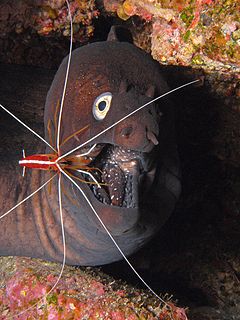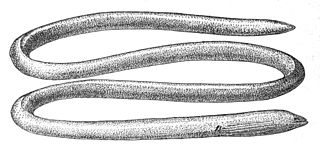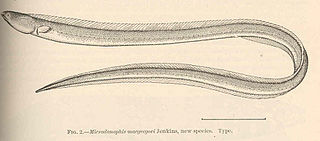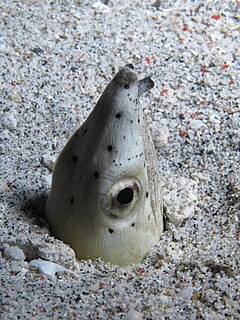
Ophichthidae is a family of fish in the order Anguilliformes, commonly known as the snake eels. The term "Ophichthidae" comes from Greek ophis ("serpent") and ichthys ("fish"). Snake eels are also burrowing eels, they are named for their physical appearance, they have long, cylindrical snakelike bodies. This family is found worldwide in tropical to warm temperate waters. They inhabit a wide range of habitats, from coastal shallows and even rivers, to depths of above 800 m (2,600 ft). Most species are bottom dwellers, hiding in mud or sand to capture their prey of crustaceans and small fish, but some are pelagic.
Echidna delicatula, the mottled moray, also known as the fine-speckled moray, is a moray eel. It was described by Johann Jakob Kaup in 1856, originally under the genus Poecilophis. It is a marine, tropical eel which is known from the Indo-Pacific, including Sri Lanka, Samoa, and Japan. It inhabits coral reefs. It can reach a maximum total length of 65 centimetres (26 in).
Echidna peli is a moray eel found in the eastern Atlantic ocean. It was first named by Johann Jakob Kaup in 1856, and is commonly known as the pebbletooth moray.

Muraena augusti is a moray eel found north of the eastern Central Atlantic ocean. It was described by Johann Jakob Kaup in 1856, originally under the genus Thyrsoidea. It is non-migratory, and dwells at a depth range of 0 to 250 metres, most often at around 0 to 50 metres.
The Celebes longfin eel is an eel in the family Anguillidae. It was described by Johann Jakob Kaup in 1856. It is a tropical eel known from freshwaters in the Western Pacific, including Indonesia, the Philippines, New Guinea, and Western and American Samoa. The eels spend most of their lives in freshwater but migrate to the ocean to breed. Males can reach a maximum total length of 150 centimetres.
The Polynesian longfinned eel, also known as the Pacific long-finned eel, is an eel in the family Anguillidae. It was described by Johann Jakob Kaup in 1856. It is a tropical eel found in freshwaters in the Pacific, including Sulawesi, Indonesia; the Society Islands, and Pitcairn. The eels spend most of their lives in freshwater, but migrate to the ocean to breed. Males can reach a maximum total length of 100 centimetres, while females can reach a maximum TL of 165 centimetres and a maximum weight of 9,000 grams.

Moringua bicolor, the bicolor spaghetti eel, is an eel in the family Moringuidae. It was described by Johann Jakob Kaup in 1856. It is a marine eel known from Japan, Indonesia, the Philippines, and the Laccadive Sea, in the Indo-West Pacific. It dwells in temperate waters at a known depth of 3 m.

The Java spaghetti eel, also known as the Java thrush-eel, Java worm eel, and the black-tailed thrush eel is an eel in the family Moringuidae. It was described by Johann Jakob Kaup in 1856, originally under the genus Aphthalmichthys. It is a tropical, marine eel which is known from the Indo-Pacific, including East Africa, the Tuamoto Islands, the Ryukyu Islands, and Micronesia. It is a burrowing species which inhabits reefs at a depth range of 2–15 m. Males can reach a maximum total length of 120 cm.
The Southern Atlantic conger, also known as the southern conger, is an eel in the family Congridae. It was described by Johann Jakob Kaup in 1856, originally under the genus Leptocephalus. It is a subtropical, marine eel which is known from the southeastern Atlantic Ocean, including from False Bay to Plettenberg Bay, South Africa and also on Tristan da Cunha Island. It is known to dwell at a depth of 100 metres. Males can reach a maximum total length of 37 centimetres.
Hoplunnis schmidti is an eel in the family Nettastomatidae. It was described by Johann Jakob Kaup in 1860. It is a marine, tropical eel which is known from Venezuela, in the western central Atlantic Ocean.
Cirrhimuraena calamus, known commonly as the fringed-lipped snake-eel or the fringelip snake eel, is an eel in the family Ophichthidae. It was described by Albert Günther in 1870. It is a marine, temperate water-dwelling eel which is endemic to western Australia, in the eastern Indian Ocean. It forms burrows in the soft bottoms of inshore waters.
Cirrhimuraena oliveri is an eel in the family Ophichthidae. It was described by Alvin Seale in 1910. It is a tropical, marine eel which is known from the Philippines, in the western central Pacific Ocean.

The fringelip snake-eel is an eel in the family Ophichthidae. It was described by Albert Günther in 1870. It is a marine, tropical eel which is known from the Indo-Pacific, including Zanzibar, Tanzania, Kosi Bay, South Africa, and the Hawaiian Islands. Its lifestyle is mostly benthic but it sometimes swims at the surface. It is olive brown in colour, with lighter colouring in the ventral region. Males can reach a maximum total length of 39 centimetres (15 in).
Cirrhimuraena tapeinoptera is an eel in the family Ophichthidae. It was described by Pieter Bleeker in 1863. It is a tropical, marine eel which is known from the Indo-West Pacific.

The highfin snake eel (Ophichthus altipennis, also known as the blackfin snake eel or the black-finned snake eel, is an eel in the family Ophichthidae. It was described by Johann Jakob Kaup in 1856, originally under the genus Microdonophis. It is a marine, tropical eel known from the eastern Indian Ocean and northwestern and western central Pacific Ocean, including Australia, French Polynesia, Indonesia, Japan, the Marshall Islands, Malaysia, the Philippines, and Papua New Guinea. It dwells at a depth range of 0 to 40 m, and forms burrows in soft inshore sand sediments. Males can reach a maximum total length of 103 cm.

The Napoleon snake eel is an eel in the family Ophichthidae. It was described by Johann Jakob Kaup in 1856, originally under the genus Poecilocephalus. It is a marine, tropical eel which is known from the Indo-Pacific, including Durban, South Africa, Mauritius, Indonesia, Japan, Australia, and the Penghu Islands. It is known to dwell at a depth of 20 metres (66 ft), and inhabits lagoons and reefs; it forms solitary burrows in sand sediments. Males can reach a maximum total length of 75 centimetres (30 in).
Ophichthus brasiliensis is an eel in the family Ophichthidae. It was described by Johann Jakob Kaup in 1856, originally under the genus Centrurophis. It is a marine, tropical eel which is known from Brazil, in the southwestern Atlantic Ocean.

The Palespotted eel is an eel in the family Ophichthidae. It was described by Johann Jakob Kaup in 1859, originally under the genus Cryptopterus. It is a marine, tropical eel which is known from the western Atlantic Ocean, including North Carolina, USA, the northeastern Gulf of Mexico, and Brazil. It dwells at a depth range of 0 to 150 metres, most often at around 5 to 40 metres. Males can reach a maximum total length of 81 centimetres (32 in), but more commonly reach a TL of 60 centimetres (24 in).

The Pacific snake-eel is an eel in the family Ophichthidae. It was described by Johann Jakob Kaup in 1856, originally under the genus Muraenopsis. It is a marine, subtropical eel which is known from the eastern central and southeastern Pacific Ocean, including California, USA, Peru, the Gulf of California, Mexico, the Galapagos Islands, Colombia, Ecuador, Costa Rica, El Salvador, Honduras, Guatemala, Nicaragua, and Panama. It dwells at a maximum depth of 155 metres (509 ft), and forms burrows in mud and sand sediments. Males can reach a maximum total length of 115 centimetres (45 in), but more commonly reach a TL of 80 centimetres (31 in).
The Kaup's arrowtooth eel is an eel in the family Synaphobranchidae. It was described by James Yate Johnson in 1862. It is a marine, deep water-dwelling eel which is known from the Indo-Western Pacific and eastern and western Atlantic Ocean, including the Faroe Islands, Iceland, Cape Verde, the Western Sahara, Nigeria, Namibia, South Africa, Greenland, France, Saint Pierre and Miquelon, the United Kingdom, Ireland, the Philippines, Portugal, Spain, the Bahamas, Brazil, Canada, Cuba, Japan, Australia, Mauritania, Morocco, and Hawaii. It dwells at a depth range of 120 to 4,800 metres, most often between 400 to 2,200 metres, and inhabits the upper abyssal zone on the continental slope. It is intolerant of the temperatures of higher waters. Males can reach a maximum total length of 100 centimetres (39 in).









